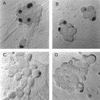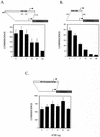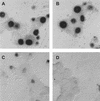Inducible cyclic AMP early repressor produces reactivation of latent herpes simplex virus type 1 in neurons in vitro
- PMID: 11222716
- PMCID: PMC115917
- DOI: 10.1128/JVI.75.6.2912-2920.2001
Inducible cyclic AMP early repressor produces reactivation of latent herpes simplex virus type 1 in neurons in vitro
Abstract
Herpes simplex virus type 1 (HSV-1) establishes a latent infection in neurons of the peripheral nervous system. During latent HSV-1 infection, viral gene expression is limited to latency-associated transcripts (LAT). HSV-1 remains latent until an unknown mechanism induces reactivation. The ability of the latent virus to periodically reactivate and be shed is essential to the transmission of disease. In vivo, the stimuli that induce reactivation of latent HSV-1 include stress, fever, and UV damage to the skin at the site of initial infection. In vitro, in primary neurons harboring latent HSV-1, nerve growth factor (NGF) deprivation or forskolin treatment induces reactivation. However, the mechanism involved in the induction of reactivation remains poorly understood. An in vitro neuronal model of HSV-1 latency was used to investigate potential mechanisms involved in the induction of reactivation of latent HSV-1. In situ hybridization analysis of neuronal cultures harboring latent HSV-1 showed a marked, rapid decrease in the percentage of LAT-positive neurons following induction of reactivation by NGF deprivation or forskolin treatment. Western blot analysis showed a corresponding increase in expression of the cellular transcription factor inducible cyclic AMP early repressor (ICER) during reactivation. In transient-transfection assays, ICER downregulated LAT promoter activity. Expression of ICER from a recombinant adenoviral vector induced reactivation and decreased the percentage of LAT-positive neurons in neuronal cultures harboring latent HSV-1. These results indicate that ICER represses LAT expression and induces reactivation of latent HSV-1.
Figures












References
-
- Barnabas S, Hai T, Andrisani O M. The hepatitis B virus X protein enhances the DNA binding potential and transcription efficacy of bZip transcription factors. J Biol Chem. 1997;272:20684–20690. - PubMed
-
- Block T M, Deshmane S, Masonis J, Maggioncalda J, Valyi-Nagi T, Fraser N W. An HSV null mutant reactivates slowly from latent infection and makes small plaques on CV-1 monolayers. Virology. 1993;192:618–630. - PubMed
-
- Bloom D C, Stevens J G, Hill J M, Tran R K. Mutagenesis of a cAMP response element within the latency-associated transcript promoter of HSV-1 reduces adrenergic reactivation. Virology. 1997;236:202–207. - PubMed
Publication types
MeSH terms
Substances
Grants and funding
LinkOut - more resources
Full Text Sources
Research Materials

